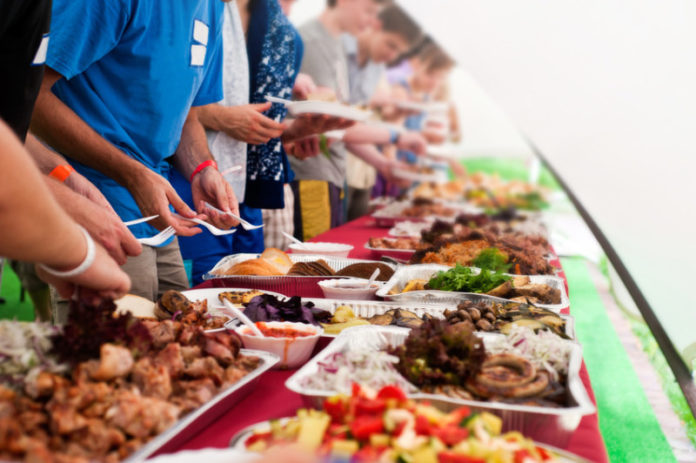
Think of it as interval training for the dinner table.
University of Florida Health researchers have found that putting people on a feast-or-famine diet may mimic some of the benefits of fasting, and that adding antioxidant supplements may counteract those benefits.
Fasting has been shown in mice to extend lifespan and to improve age-related diseases. But fasting every day, which could entail skipping meals or simply reducing overall caloric intake, can be hard to maintain.
“People don’t want to just under-eat for their whole lives,” said Martin Wegman, an M.D.-Ph.D. student at the UF College of Medicine and co-author of the paper recently published in the journal Rejuvenation Research. “We started thinking about the concept of intermittent fasting.”
Michael Guo, a UF M.D.-Ph.D. student who is pursuing the Ph.D. portion of the program in genetics at Harvard Medical School, said the group measured the participants’ changes in weight, blood pressure, heart rate, glucose levels, cholesterol, markers of inflammation and genes involved in protective cell responses over 10 weeks.
“We found that intermittent fasting caused a slight increase to SIRT 3, a well-known gene that promotes longevity and is involved in protective cell responses,” Guo said.
The SIRT3 gene encodes a protein also called SIRT3. The protein SIRT3 belongs to a class of proteins called sirtuins. Sirtuins, if increased in mice, can extend their lifespans, Guo said. Researchers think proteins such as SIRT3 are activated by oxidative stress, which is triggered when there are more free radicals produced in the body than the body can neutralize with antioxidants. However, small levels of free radicals can be beneficial: When the body undergoes stress — which happens during fasting — small levels of oxidative stress can trigger protective pathways, Guo said.
“The hypothesis is that if the body is intermittently exposed to low levels of oxidative stress, it can build a better response to it,” Wegman said.
The researchers found that the intermittent fasting decreased insulin levels in the participants, which means the diet could have an anti-diabetic effect as well.
The group recruited 24 study participants in the double-blinded, randomized clinical trial. During a three-week period, the participants alternated one day of eating 25 percent of their daily caloric intake with one day of eating 175 percent of their daily caloric intake. For the average man’s diet, a male participant would have eaten 650 calories on the fasting days and 4,550 calories on the feasting days. To test antioxidant supplements, the participants repeated the diet but also included vitamin C and vitamin E.
At the end of the three weeks, the researchers tested the same health parameters. They found that the beneficial sirtuin proteins such as SIRT 3 and another, SIRT1, tended to increase as a result of the diet. However, when antioxidants were supplemented on top of the diet, some of these increases disappeared. This is in line with some research that indicates flooding the system with supplemental antioxidants may counteract the effects of fasting or exercise, said Christiaan Leeuwenburgh, Ph.D., co-author of the paper and chief of the division of biology of aging in the department of aging and geriatric research.
“You need some pain, some inflammation, some oxidative stress for some regeneration or repair,” Leeuwenburgh said. “These young investigators were intrigued by the question of whether some antioxidants could blunt the healthy effects of normal fasting.”
On the study participants’ fasting days, they ate foods such as roast beef and gravy, mashed potatoes, Oreo cookies and orange sherbet — but they ate only one meal. On the feasting days, the participants ate bagels with cream cheese, oatmeal sweetened with honey and raisins, turkey sandwiches, apple sauce, spaghetti with chicken, yogurt and soda — and lemon pound cake, Snickers bars and vanilla ice cream.
“Most of the participants found that fasting was easier than the feasting day, which was a little bit surprising to me,” Guo said. “On the feasting days, we had some trouble giving them enough calories.”
Leeuwenburgh said future studies should examine a larger cohort of participants and should include studying a larger number of genes in the participants as well as examining muscle and fat tissue.
Story Source:
The above story is based on materials provided by University of Florida. Note: Materials may be edited for content and length.
Journal Reference:
- Martin P Wegman, Michael Guo, Douglas M Bennion, Meena N Shankar, Stephen M Chrzanowski, Leslie A Goldberg, Jinze Xu, Tiffany A Williams, Xiaomin Lu, Stephen I Hsu, Stephen D Anton, Christiaan Leeuwenburgh, Mark L Brantly. Practicality of Intermittent Fasting in Humans and its Effect on Oxidative Stress and Genes Related to Aging and Metabolism. Rejuvenation Research, 2014; 141229080855001 DOI: 10.1089/rej.2014.1624
